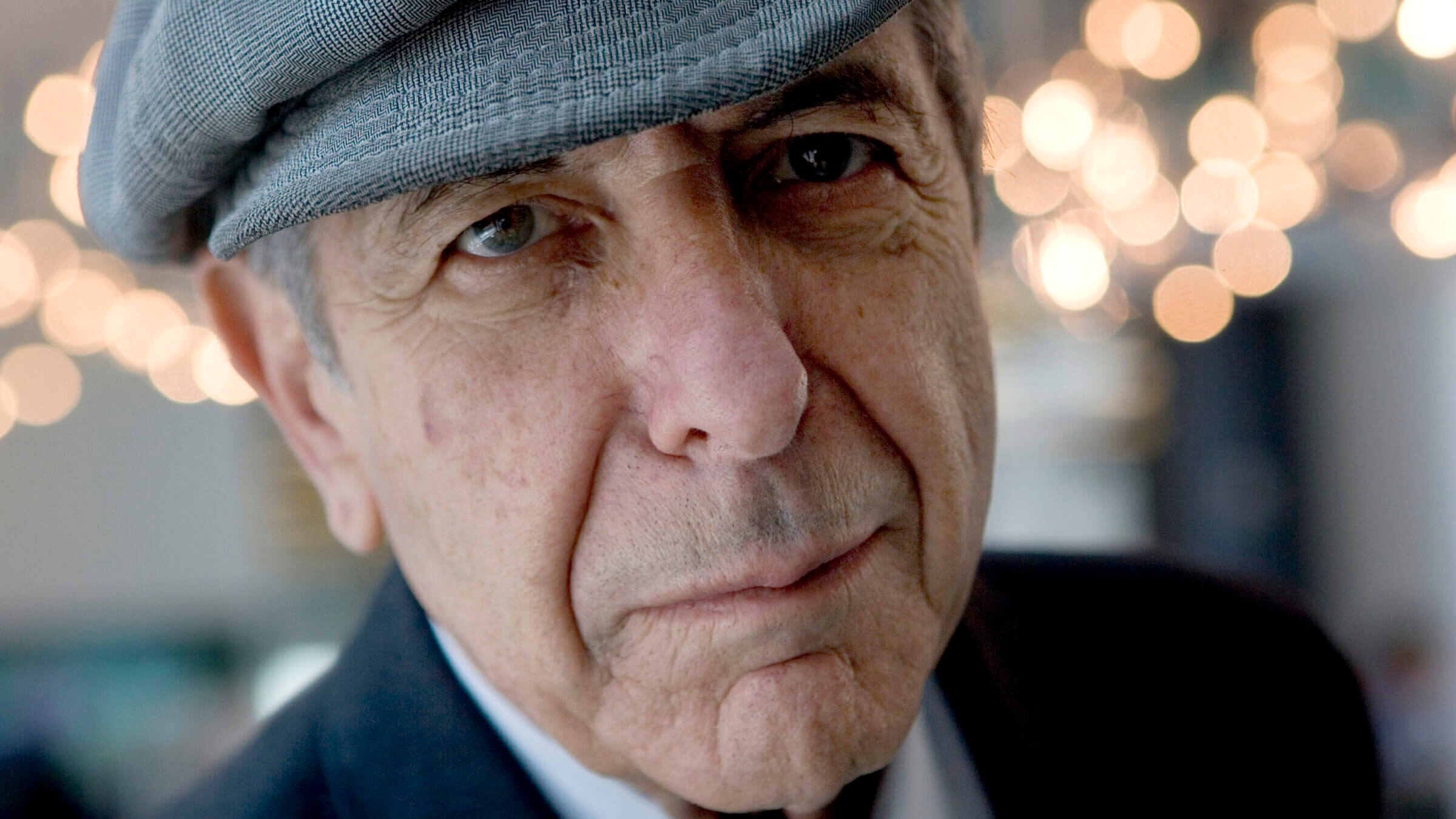Has Leonard Cohen’s most Jewish song become a ‘Hallelujah’ for darker times?
in ‘The Patient’ and ‘Bones and All,’ Cohen’s ‘You Want It Darker,’ which features a cantor and synagogue choir, is having a moment

Leonard Cohen, circa 2006 Photo by Getty Images
This post contains spoilers for the series finale of FX’s “The Patient.”
It’s not every day you hear Abraham’s Hebrew words to God while watching TV — particularly not after sequences where waifish movie stars commit grisly murders.
And yet, “You Want It Darker,” the elegiac, Grammy-winning title song of Leonard Cohen’s 2016 album, has recently served as the soundtrack for both the grim conclusion of FX’s “The Patient” and the trailer for Luca Guadagnino’s “Bones and All,” which sees Timothée Chalamet playing a cannibalistic drifter. Chalamet chose the song himself, and he’s in good company. The track was also the theme song for Netflix’s “Black Earth Rising,” about a survivor of the Rwandan genocide. Earlier this month, Iggy Pop covered it for a Leonard Cohen tribute album.
Might the song become “Hallelujah” for a dark-tinged moment in history?
Though it’s unlikely to reach those heights, Cohen’s growling apocalyptic vision, in which he both challenges God and tells Him he’s ready for death, certainly sets a mood.
The song’s tone is well matched to the montage of images in the “Bones and All” trailer, which kicks off with the verse “There’s a lover in the story,” and shows, well, lovers. The refrain of “Hineni, hineni,” precedes violence (tire irons, blood-streaked clothes) that picks up with the pre-chorus: “Magnified, sanctified/ Be thy holy name/ Vilified, crucified/ In the human frame.” Those words, of course, are adapted from the Kaddish — more on that later.
Gideon Zelermyer, a soloist in “You Want It Darker” and the cantor at Shaar Hashomayim in Montreal, Cohen’s childhood synagogue, thinks the song’s popularity is likely a sign of the times.
“Leonard already had this reputation for being a prophet of darkness and he dies the night before Trump gets elected and releases this song about the dark nature of not just humanity but the dark nature of God in some ways,” said Zelermyer. After a pandemic, the murder of George Floyd and the ongoing crisis in Ukraine, Zelermyer thinks people are drawn to something “more solemn” and “less flippant.”
“People are in a dark place, and Leonard had a way of plumbing those depths even further and doing it in an incredibly rich way,” said Zelermyer.
In a video posted shortly after Cohen’s death, the late Rabbi Jonathan Sacks related the song’s lyrics — and the “lover” verse in particular — to the parsha Vayera, detailing the binding of Isaac, in which the word “hineni” (“here I am”) is invoked three times.
“‘There’s a lover in the story,’” Sacks said, quoting Cohen. “The story begins by God saying to Abraham, ‘Take your son, your only one, the one whom you love.’ This is the first time the word ‘love’ appears in the Hebrew Bible.”
“‘But the story is still the same,’” Sacks said as he went on with his drash of Cohen’s own midrash. “Abraham loved his son, but God still told him to sacrifice him. ‘There’s a lullaby for suffering.’ Leonard Cohen knew that some of our most powerful liturgical songs in Judaism are very sad, they’re lamentations, ‘but there’s a paradox to blame,’ which is, out of love for God, we sometimes kill in his name.”
In the “Bones” trailer, a section of another verse is substituted after the “paradox” line to better reflect the journeyings of two fine young cannibals (Chalamet and Taylor Russell) through Reagan-era America: “I didn’t know I had permission to murder and to maim.”
While it remains to be seen how the song will figure into “Bones and All,” in “The Patient,” which focuses largely on intense father-son relationships, the texts speak to each other, though the dynamic is somewhat inverted from the story Cohen (repeatedly) used for inspiration.
“The Patient” follows Steve Carell’s Alan Strauss, a therapist held captive by his patient, Sam, a serial killer. While chained to a bed in the basement, Alan works through his own fraught relationship with his son, Ezra, who became Orthodox, upsetting the balance of the family and offending the sensibilities of his late wife, a Reform cantor.
Ezra, like Abraham, is a pious figure, and hopes to rescue the father who has wronged him. Sam, whose homicidal tendencies likely stem from his abusive childhood, confronts his father in the finale, but ultimately he spares his life. Alan isn’t so lucky. (In Genesis 22, a ram, trapped in a thicket, is sacrificed in Isaac’s stead; here, one father is substituted for another and a straightforward Oedipal conclusion is averted.)
Sacks recognized that Cohen’s song was riffing on a commentary of the would-be sacrifice of Isaac from Rashi, which says Abraham petitioned God “in protest against the apparent cruelty and willfulness of the entire story.” In the series conclusion, Alan does the same thing to Sam, who holds his life in his hands — he doesn’t simply submit in the spirit of “hineni.” In a subversion of the usual Akedah — the Hebrew name for the binding of Isaac — he threatens to slice the throat of Sam’s mother to broker his release.
This vision of God — and inevitable death — is even bleaker than what Cohen devised. When the tune finally appears over the credits, it’s right after Ezra begins to speak about himself to a therapist. He only gets out the word “I” before the credits roll and the Shaar Hashomayim choir takes over. It’s a wry punchline of the sort Cohen would surely appreciate: “Doc, you can’t get much darker than this.”
But it’s almost certainly no mistake that the Kaddish, both the name of an episode of “The Patient” and a prayer recited by victim and murderer, figures in both the show and Cohen’s pre-chorus, or that Ezra, whose mother was a cantor, has his confession interrupted by cantorial music.
Zelermyer said it was important to Cohen, while producing the song, that he, the cantor, and his choir, provided a traditional sound. That’s not to say that the song, like so much of Cohen’s mixing of the sacred and profane, hasn’t pushed the boundaries of what’s acceptable at shul.
“The first place that ‘You Want It Darker’ actually crept its way into pop culture was before the song and album were even released — it was part of the soundtrack for a ‘Peaky Blinders’ episode. And it was the backdrop to an erotic asphyxiation scene,” Zelermyer said. “I was like ‘Oh my God, I hope the synagogue’s board doesn’t find it!’”
Sonically, it’s easy to see why “You Want It Darker,” with its brooding edge, might be in demand. Even in his 80s — on the edge of death, even — Cohen could cut a sexy song. Lyrically, he conveyed resignation, human cruelty and the caprice of the almighty all at the same time. While not as versatile as “Hallelujah,” it’s cryptic and evocative enough to be an effective soundtrack, whether or not you know what the word “hineni” means.
Even if you don’t, you surely understand the darkness of the human condition — though maybe not as well as Cohen did.

















